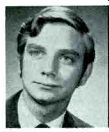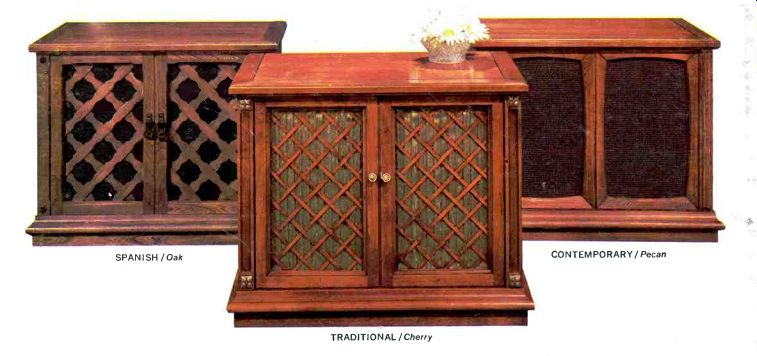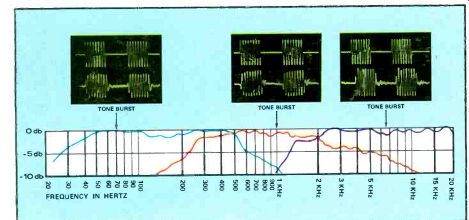
Number 74 in a series of discussions by Electro-Voice engineers.
OF HILLS AND DALES RICHARD MILLER , Student Engineer
A recent Electro-Voice project points up the close kinship between transducers intended for widely varying purposes. In this instance the task was to develop, for another division of Gulton Industries, an improved transducer for the measurement of surface roughness.
In many respects, the device is quite similar to a phono cartridge. It includes a small ceramic element and a diamond stylus that traces the surface to provide an electrical output analogous to the surface variations under test. Parameters for the gauge must relate exactly to the USA Standards for surface measurement.
Using a 0.5 mil spherical tip diamond stylus, the transducer is typically driven across the surface to be measured at a rate of about 1/$"/second. A meter provides a readout of average amplitude variation in micro-inches.
Alternatively, the surface can be plotted with a graphic recorder. An output of 0.10 millivolt is equivalent to 1 micro-inch deflection of the stylus. This output relationship is maintained even though the stylus tip is not exactly perpendicular to the surface under test.
In order to accommodate a broad range of surface irregularities, equalized response from the probe is flat from 4 to 1200 Hz.
and the performance is checked on specially prepared phonograph records played at sub-normal speeds. Because surface measurement must not harm or deform the product under test, the probe must exhibit high compliance. While a typical ceramic phono cartridge may be rated at 5x10^-6 cm/dyne, and a good magnetic might measure 20x10^-6cm/dyne, the surface gauge ceramic system has a rated compliance of 50x10^-6cm/dyne.
This high compliance also reduces element breakage, a serious problem with earlier designs.
Surface measurement systems of this type find wide application in thick-film electronic circuit production, where varying surface characteristics can affect performance. The gauges are also used to determine quality of metal parts finish, predict heat transfer ability, and other applications where surface texture is critical.
For reprints of other discussions in this series, or technical data on any E-V product, write: ELECTRO-VOICE, INC., Dept. 1193A 602 Cecil St., Buchanan, Michigan 49107
A SUBSIDIARY OF GULTON INDUSTRIES. INC.
==============

SPANISH/Oak; CONTEMPORARY/Pecan; TRADITIONAL /Cherry
Un-retouched photographs and the unvarnished truth about the new ARIES Console Speaker System.
If you are as serious about musical reproduction as we are, the following discussion may help you in choosing your next speaker system. And the actual response curves and tone burst tests may prove most revealing when compared with other speaker systems currently available.
Aries is an uncommon speaker system. Larger than the ubiquitous bookshelf speakers for a very sound reason: greater internal volume permits a worthwhile extension of bass with lower distortion and higher efficiency. Effective use of this volume comes from a 12" woofer with 9 1/2 pound magnet structure, new sealed-foam half-roll surround, and rigid deep-cone geometry. It's a combination that insures 3/4" linear cone movement, precise transient response, and high power handling capacity without frequency doubling.
The mid-range was designed with equal care. A specially treated 6" cone speaker is mounted in its own sealed inner enclosure. Speaker resonance is well below the crossover point to insure peak-free response and clean transients in this sensitive part of the spectrum. Oscilloscope testing of every unit is routine so that laboratory standards are maintained in production.
The Aries 2 1/2" cone/dome tweeter is particularly unique. For instance, to obtain ultimate response, damping compound is metered onto the cone within a tolerance of ±0.001 oz. And control of cone/dome materials insures a radiation area that varies predictably with frequency to insure uniform dispersion at all frequencies.


Even the crossover network is unusual.
Four inductors (iron-core type for the woofer to avoid losses), three capacitors (with a Mylar type for the tweeter to maintain response beyond the high frequency limitations of electrolytic types), and a 5-position rotary ceramic switch offers precise control with up to 10 db attenuation at 10 kHz.
But Aries is more than a distinguished music reproducer. It is also handsome furniture in its own right. Tasteful design and robust construction set Aries apart from the anonymous styles of the past.
In every detail from the hidden 2' x 4" bracing to the authentic hardware and richly finished hardwood veneers, Aries can be an attractive addition to your home ... a delight to ear and eye.
See and hear the new Aries at your E-V dealer's soon. Look ... touch ... and above all, listen. It can be an eye-opening experience. $275.00.
ELECTRO-VOICE, INC., Dept. 1194A
602 Cecil Street, Buchanan, Michigan 49107
A SUBSIDIARY OF GULTON INDUSTRIES, INC.
--------------
(Audio magazine, 11/1969)
Also see:
ABZ's of Stereo FM--Modern Switching-Circuit Decoder
= = = =